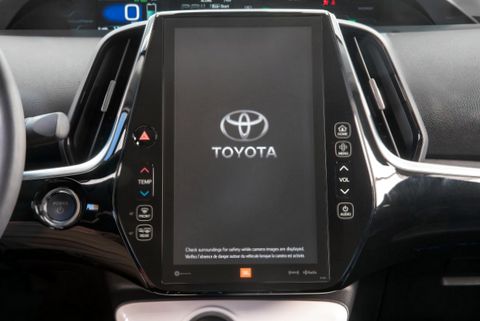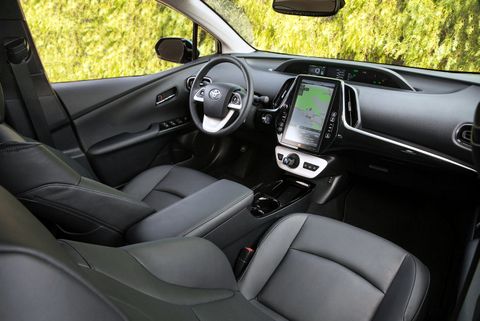Toyota’s Fuel Economy Leader
I reviewed the all-new 2017 Toyota Prius Prime in April last year, and was clearly impressed with the high fuel economy of this four-passenger, four-door hatchback. There have been no significant changes to the 2018 Toyota Prius Prime, and you can read our reviews from last year here, here, and here (three different reviewers took it out for a spin; we thought it was that significant of a car).

Clean Fleet Report felt it was worth driving the 2018 Toyota Prius Prime to see if our impressions have changed in any way. We are glad we did, and here are a few updates.
Fuel Economy
After one week in the 2018 Toyota Prius Prime I was pleased to experience even better fuel economy than the 2017 model. Maybe it was how we were driving or the type of traffic we encountered, but I saw a nice increase in miles per gallon. Last year, the 2017 Prius Prime returned 58.1 mpg over 317 miles while tackling Southern California freeways. Fast forward to the 2018 model, where over 690 miles we averaged 61.7 mpg.
With an EPA rating at 55 city/53 highway/54 combined, to say we are impressed with the efficiency of Toyota’s Hybrid Synergy Drive is an understatement. We are confident that if using the full 25 miles of all-electric drive range at all times, our average would have gone up.
On the Road

We sensed a small driving improvement in the 2018 Toyota Prius Prime. It still is not fast, 0 – 60 times in the mid-10-second range. You really need to push the accelerator pedal all the way down to get momentum going. On the open road the Prius Prime is easy to drive, it tracks well with a stable and sure ride. Cornering ability is only within the limits of the 15-inch tires, which let you know real fast when they have been pushed too far and too hard. The bottom line is that the car is not exciting to drive, but then again, Toyota is not marketing it as a sporty car.
Interior
There are no changes to the layout and systems of the Prius Prime, year-over-year. This is where, for Clean Fleet Report, there is an issue. In the Plus, Premium and Advanced trim levels (the last of these is what we were testing) you get the 7.0-inch, iPad-like touch screen. Centered vertically in the dash, this is where all your controls are, except for the audio and telephone controls on the steering wheel. What we miss are knobs, buttons and switches – of any kind. The touch screen is not always quick to respond to commands and, having to go between screens for the different systems was an extra, unneeded step.

The second annoyance are the gauges being centered on the dash, and not directly in-front of the driver. A head-up display has been added since our review of the 2017 Prius Prime, so this helped a bit. But not enough, as there is just something not quite right about always looking to your right to keep abreast of your driving systems.
Design

Redesigned for 2017, the 2018 Toyota Prius Prime has not changed. So, if you liked it then you will like it now.
Pricing
There has been a $200 price increase for each of the three Prius Prime models. The 2018 pricing, not including the $865 delivery, processing and handling fee.
Prime Plus $27,300
Prime Premium $29,000
Prime Advanced $33,300
Observations: 2018 Toyota Prius Prime Advanced
The stellar fuel economy of Toyota’s alternative fuel vehicles vaults them over and above most, if not all, cars on the road. The 2018 Toyota Prius Prime offers smooth operation and a seamless transition between gasoline and electric drive modes. The easy-driving attributes make it a serious contender for anyone who takes frequent long trips, or has a long daily commute. If your usual driving pattern is under twenty-five miles each day, then you can go that far on pure electricity.
Toyota’s reliability reputation is well-earned, and this extends to the Prius models. The beauty of a plug-in hybrid is the 600+ miles of driving range, which means stopping to fill the tank could be a far less common part of your life.
Whatever you end up buying, Happy Driving!
Related Stories You Might Enjoy—PHEV Options
Road Test: 2018 Hyundai Ioniq PHEV
News: Subaru Crosstrek PHEV Due at Year’s End
Road Test: 2018 Mini Countryman PHEV
Road Test: 2018 Kia Niro PHEV (John’s view)
Road Test: 2018 Kia Niro PHEV (Steve’s view)
Road Test: 2018 Honda Clarity PHEV
Road Test: 2017 Kia Optima PHEV
Road Test: 2017 Ford Fusion Energi PHEV
Road Test: 2017 Hyundai Sonata PHEV
Road Test: 2017 Chevrolet Volt
Disclosure:
Clean Fleet Report is loaned free test vehicles from automakers to evaluate, typically for a week at a time. Our road tests are based on this one-week drive of a new vehicle. Because of this we don’t address issues such as long-term reliability or total cost of ownership. In addition, we are often invited to manufacturer events highlighting new vehicles or technology. As part of these events we may be offered free transportation, lodging or meals. We do our best to present our unvarnished evaluations of vehicles and news irrespective of these inducements.
Our focus is on vehicles that offer the best fuel economy in their class, which leads us to emphasize electric cars, plug-in hybrids, hybrids and diesels. We also feature those efficient gas-powered vehicles that are among the top mpg vehicles in their class. In addition, we aim to offer reviews and news on advanced technology and the alternative fuel vehicle market. We welcome any feedback from vehicle owners and are dedicated to providing a forum for alternative viewpoints. Please let us know your views at publisher@cleanfleetreport.com.

4 thoughts on “Flash Drive: 2018 Toyota Prius Prime PHEV”